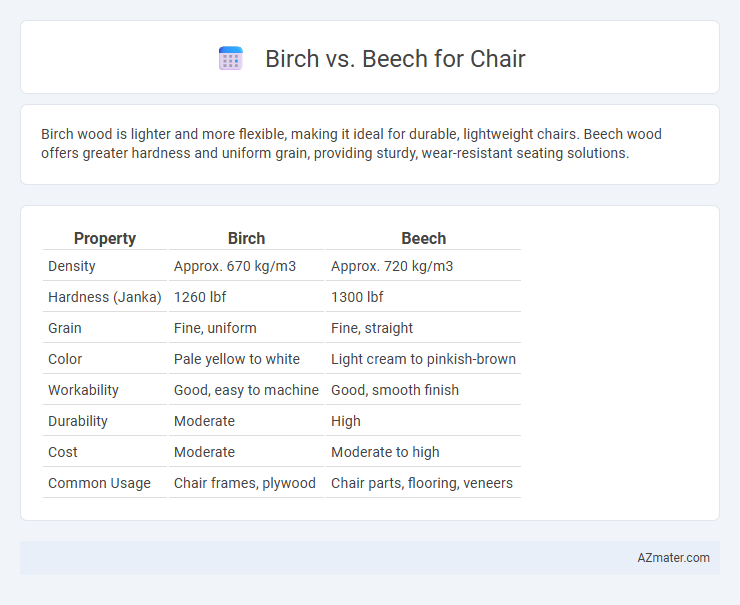Birch wood is lighter and more flexible, making it ideal for durable, lightweight chairs. Beech wood offers greater hardness and uniform grain, providing sturdy, wear-resistant seating solutions.
Table of Comparison
| Property | Birch | Beech |
|---|---|---|
| Density | Approx. 670 kg/m3 | Approx. 720 kg/m3 |
| Hardness (Janka) | 1260 lbf | 1300 lbf |
| Grain | Fine, uniform | Fine, straight |
| Color | Pale yellow to white | Light cream to pinkish-brown |
| Workability | Good, easy to machine | Good, smooth finish |
| Durability | Moderate | High |
| Cost | Moderate | Moderate to high |
| Common Usage | Chair frames, plywood | Chair parts, flooring, veneers |
Introduction: Birch vs Beech Chairs
Birch and beech are two popular hardwoods commonly used in chair manufacturing due to their strength and durability. Birch offers a fine grain and pale color, making it ideal for sleek, modern chair designs, while beech provides a slightly harder texture and warm, reddish tones favored in traditional furniture. Both woods exhibit excellent shock resistance and stability, ensuring long-lasting chairs suitable for various interior styles.
Botanical Differences Between Birch and Beech
Birch wood, derived from Betula species, features fine grains and pale color with notable catkins as reproductive structures, contrasting with Beech wood from Fagus species, which exhibits tighter grain patterns and a more reddish hue. Botanic distinctions include birch's softer, lightweight nature and rapid growth under temperate climates, while beech trees mature slower and display a dense hardness ideal for durability. These botanical characteristics influence chair manufacturing choices, balancing aesthetic appeal and functional strength.
Wood Grain and Appearance Comparison
Birch wood features a fine, uniform grain with a light, creamy color that often displays subtle waves, making it ideal for smooth, modern chair designs. Beech wood has a tight, straight grain with a slightly reddish or pinkish hue, offering a warm and classic look commonly favored for traditional chair styles. The difference in grain texture and color between birch and beech significantly influences the aesthetic appeal and can guide the choice based on desired chair design and interior decor.
Strength and Durability Analysis
Birch wood offers superior strength and hardness, making it highly resistant to dents and scratches, which ensures long-lasting durability for chair construction. Beech wood, while also strong and hard, features a tighter grain structure that provides excellent stability and resistance to wear over time. Both woods excel in strength and durability, but birch typically outperforms beech in impact resistance and load-bearing capacity for chairs.
Workability for Chair Construction
Birch offers excellent workability for chair construction due to its fine, consistent grain and hardness, allowing precise machining and sanding with minimal splintering. Beech wood, known for its tight grain and strength, provides smooth shaping and is ideal for steam bending, enhancing ergonomic chair designs. Both woods are durable, but birch's easier finishing properties make it particularly popular for detailed and high-quality chair craftsmanship.
Cost and Availability of Birch vs Beech
Birch wood is generally more affordable than beech due to its faster growth rate and wider availability, making it a cost-effective option for chair manufacturing. Beech, while typically more expensive, offers consistent grain and higher density, contributing to its durability and aesthetic appeal. Availability of birch is higher in North America, whereas beech is more common in Europe, influencing regional price variations and sourcing decisions.
Finishing and Staining Properties
Birch wood offers a smooth grain that absorbs stains evenly, resulting in a uniform finish ideal for chairs requiring consistent color. Beech, with its tighter grain and slight natural pinkish hue, can sometimes blotch when stained but responds well to pre-conditioning treatments for a more controlled finish. Finishing beech chairs often requires sealing techniques to enhance durability, whereas birch's receptive surface allows stains and finishes to penetrate deeply, ensuring long-lasting aesthetic appeal.
Environmental Impact and Sustainability
Birch chairs typically have a lower environmental impact due to the tree's faster growth rate and higher yield per hectare compared to beech, which grows more slowly and requires longer rotation periods. Beech wood is denser and more durable, offering longevity that can reduce the need for replacement, enhancing its sustainability over time. Sustainable sourcing certifications such as FSC or PEFC for both species ensure responsible forest management, but birch's rapid renewability generally makes it a more eco-friendly option for chair manufacturing.
Comfort and Performance in Chair Design
Birch wood offers exceptional strength and a smooth grain that enhances chair durability and support, making it ideal for ergonomic designs focused on comfort. Beech wood features a slightly softer texture and excellent shock absorption, providing a cushioned seating experience favored in traditional and modern chair craftsmanship. Both woods perform well, but birch excels in longevity and structural integrity, while beech is preferred for its natural flexibility and resilience under pressure.
Best Choice: Birch or Beech for Your Chair?
Beech wood offers superior strength and durability for chair construction, making it an excellent choice for long-lasting furniture. Birch provides a smooth finish and appealing grain pattern, ideal for aesthetic-focused designs but with slightly less hardness than beech. For a balance of resilience and appearance, beech is generally the best choice for sturdy, everyday-use chairs.

Infographic: Birch vs Beech for Chair
 azmater.com
azmater.com